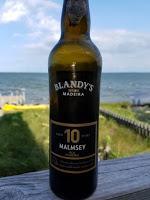"I went last night to the Ball, where the Company Suffered more by the cold which was excessive than I ever knew any Company suffer in my Life. The Dancers only were comfortable. I came home and went into a warm bed and had a fine Perspiration, occasioned I believe by my drinking three Glasses of Madeira Wine at supper and two more after I came home, which has relieved me from all cold and I feel very well this morning. The Company owing to the Weather was not large." Letter from John Adams to Abigail Adams, 22 February 1799
 It's common knowledge that the founding fathers enjoyed their Madeira, a fortified dessert wine produced in the Portuguese archipelago of Madeira. Our second President was extremely fond of this beverage and recently A Museum Just Uncovered 221-Year-Old Wine Meant to Honor John Adams's Presidency. One reason behind their affection for Madeira was that the wine was also able to travel long distances without spoiling. And in fact, the long sea voyages actually transforms the flavor of the wine by exposing it to heat and movement.
It's common knowledge that the founding fathers enjoyed their Madeira, a fortified dessert wine produced in the Portuguese archipelago of Madeira. Our second President was extremely fond of this beverage and recently A Museum Just Uncovered 221-Year-Old Wine Meant to Honor John Adams's Presidency. One reason behind their affection for Madeira was that the wine was also able to travel long distances without spoiling. And in fact, the long sea voyages actually transforms the flavor of the wine by exposing it to heat and movement.In contemporary times Madeira winemakers mimic sea voyages by heating the wine. "The wine is placed in stainless steel vats that are heated via a serpentine method. Hot water, at a temperature between 45 and 50 degrees Celsius [or approximately 115 °F], runs through this serpentine system for a period of never less than three months. Once this heating process ("estufagem") is completed, the wine is subjected to a rest period ("estágio") of at least 90 days in order to acquire the conditions that will make it possible for the oenologist to finish the wine so that it may be placed in a bottle with the required quality guarantee."
One historical producer is Blandy's Madeira, a family owned winery that has been operating continuously for over two centuries. In 1989 they partnered with the Symington Wine Family to form the Madeira Wine Company (MWC). MWC utilizes two maturation processes. The first is called Armazém de Calor where the wine is "stored in large wooden casks in a specially designed room outfitted with steam-producing tanks or pipes that heat the room, creating a type of sauna. This process more gently exposes the wine to heat, and can last from six months to over a year". Second, during the aging process the wine is aged " in seasoned American oak casks in the traditional ‘Canteiro’ system, whereby the casks of this wine are gradually transferred from the top floors of the lodge, where it is naturally warmer, to the middle floors and eventually to the ground floor where it is cooler. During this totally natural ageing, the wine underwent regular racking before finally being bottled".
As a side note Madeira wine can be made from the following grape varieties: Tinta Negra, Sercial,Verdelho, Terrantez, Bual (Malvasia Fina), Malvasia (usually Malvasia Branca de São Jorge).
To celebrate the 4th of July (yes, I realize the tardiness of this post), I received a sample bottle of their Blandy’s 10 Year Old Malmsey Madeira ($29). The wine is named after the vat of wine that the Duke of Clarence drowns in in Richard III. And it clearly satisfies the founders affinity for Madeira wine. Dried fruits is the initial dominant flavor, followed by raisins and subtle chocolate. The sweetness is neither gritty or jammy and the tangy acidity balances the sugar seamlessly. I thoroughly enjoyed this wine and am sad to see it disappear. Cheers to Adams, the 4th, and Madeira wine.
